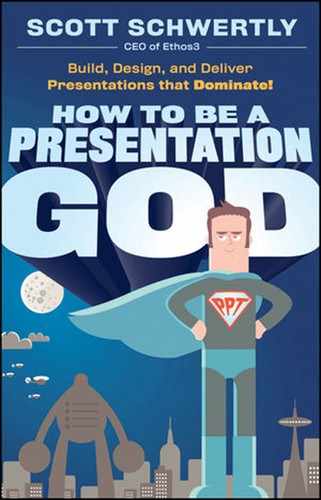Chapter 8. Styles and Approaches
Have you ever noticed that there is no such thing as an uncreative child? Take a look around the next time you're at the park: How many briefcases do you see? Are any three-year-olds taking meeting notes so that there is a record of the day's play? Are any of the children in the sandbox pontificating about style guide violations?
Of course, by the time children reach grade school, we adults have usually found a way to tamp down their wild spirit. Cars don't have mouths. Grass can't be pink. Alligators don't have sheep heads. Blah, blah, blah.
I've never been able to discover what adults love so much about conformity. Maybe it's the month-by-month pressure of bills that leads us to crave predictability. Or maybe we trade the pursuit of novel excitement for stability (try as we might). Whatever it is that leads us to shun creativity, it is a thorough impulse that happens to nearly all of us. Reclaiming the free-spirited brain of youth takes a concerted level of energy and practice; however, it is a vital step in the quest for presentation god status.
The first thing we need to do is rethink our definition of creativity. If it means the ability to create something new or unseen, then why have we been designating landscape artists as creative? If it means, quite simply, having the ability to create a tangible object of any sort—be it art, furniture, writing, songs—then why do we consider a philosopher's ideas so creative? The truth is, most of our assumptions about what is and is not creative are handed down, generation after generation, without a second thought as to accuracy, consistency, or relevance. If we feel we fit the archetypal creative mold, we live with the sense that we are, indeed, creative. If we somehow do not, we surrender the benefits of creative living to others.
I see this trend frequently among businesspeople. Business is hardly considered an art, yet millions upon millions of businesspeople create marketing programs, new products or services, more efficient organizational structures—the list goes on and on—every single day. Years ago, upon recognizing that nearly everyone with whom I came in contact was creative in some respect, I began to develop a new, more inclusive definition of creativity, one that didn't reserve the honorable distinction for prodigious and eccentric hermits living in the backwoods of the Rocky Mountains, for instance.
My definition is this: Creativity is problem solving. It fits across the board: The landscape painter identifies a problem—that a beautiful scene is fleeting and changeable—and seeks to capture it on canvas. The philosopher is keenly aware of a logical inconsistency and seeks to address it in the mind. The businessman recognizes an unmet desire in society and brings a remedy to market. If we are going to transmit our ideas to one another, we first need to cultivate a sincere confidence that our ideas are worth their weight in gold. Imagine if Michelangelo had lacked the confidence to put his heart and soul into the Sistine Chapel account or if Andy Warhol had deferred to the style of other, more "creative" people. The first quality of humanity's greatest creative minds is not creativity; that elusive first quality is confidence.
Begin to separate creativity and execution in your mind. Creativity is about solving a problem; for example, you need the board's support for a new human resources campaign. How can you get board members to follow you? Execution is the sterile, technical implementation of your creative ideas. If you've never been much of an artist, it is execution—not creativity—with which you need help. The landscape painter's perspective is creative; the brushstrokes are execution of the creative vision. Failing to recognize the difference—especially in the realm of presentations—can have serious consequences. If you have a creative vision, you can find a way to execute it. But if you have no vision, your presentation will surely suffer.
Remember, creativity requires confidence above all else. So it's no coincidence that excellent presentations depend upon confidence as well. When we hesitate to put our best ideas forward and instead invite others to step in and do the thinking for us, we commit a grievous sin against the presentation we will give. It is our message. We are responsible for the results and consequences of what is said on stage. After all, great coaches don't outsource the training and then show up for the big game; they become great by leading excellent training programs. Your presentation is the same: You have a responsibility to be intimately involved with both its construction and design.
Now, if you lack artistic skills, it is always a good idea to outsource the execution to someone who can bring your creativity to life. Whereas everyone is truly creative, not everyone is proficient with advanced design software or current design trends. We need to separate creativity and execution because our message is our baby—it doesn't makes sense to let someone else raise it—but our vision is not complete without skill.
So how do we engage our inner creative beast? If we're no longer passing the creative buck, how do we envision and communicate our creative ideas to the people who need to catch our message most? Like many of you, my professional career has required me to rehabilitate my creative mind. In the process, I've identified some perspectives and strategies that are extremely helpful when tasked with plucking intangible thoughts out of my brain and putting them into a roomful of audience members' hearts.
